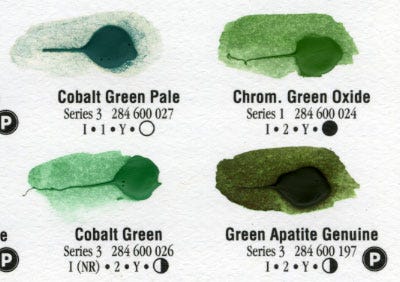We're looking at a test sheet Daniel Smith watercolors provides that you can use to try out their paints before you buy. These sheets can be bought in 60-238 color swatches, and they have real paint on them. All you do is run a wet watercolor brush over the paint daub and it actives the paint sample so you can see for yourself the effect you're going to get!
Like for oil paints, there are codes for lightfastness and codes for transparency on each sample. You'd assume all watercolors are transparent, but some will be surprised how deep and opaque watercolors can get.
As you can see on this sample, the activated colors show a wide range of transparency.
The Cobalt Green Pale is VERY transparent. That's not because I didn't use much water on it, that's just how the paint goes down. The other three samples are opaque and semi-opaque colors, and you get a lot of bang out of your buck using them. If you want a really transparent wash, you know which paint to use. You want a deeper color, you know where to go. And you don't have to remember 238 colors. You have a handy chart!
The P symbol is an indication that the paint uses real mineral pigments. This doesn't always mean the paint is better as some synthetic pigments actually perform better than natural ones. But these are high quality proprietary formulations for this company.
You can also see a couple of other codes that aren't on tubes of oil paint: staining and granulation.
Staining is really important in watercolor, because as most of you know, watercolor is pretty much one and done. If you make a mistake it's hard to correct.
But some paints will lift almost entirely with the careful application of water and a bit of daubing. I even use an electric eraser to lift paint and get airbrush-like effects as you can see here.
A paint with a 4 rating is really going to dig into that paper. A paint with a 1 rating can be lifted more easily.
Then there's Granulation.
Look at the top sample. Note how it's got a but of graininess in that wash effect. It's on the exact same paper as the bottom color sample, which came out very smooth.
The top sample shows granulation and the bottom sample shows no granulation.
If you're looking for texture in your paint, granulation is what you want. If you want a very smooth wash, choose a paint with no granulation. Granulation may be good for clouds and landscapes. But no granulation may be best for painting faces or clothing.
You will see some other codes on paint: they are usually manufacturer numbers or price codes. I didn't go over them because they don't indicate anything you need to know beyond knowing how to reorder a tube!
As you can see, painting isn't about just picking a color. You have a wide array of choices in your paints, even within one brand of paint. You have the power to pick and choose effects.
With a little study and practice, you'll have many tools at your disposal as an artist simply by knowing the secret language of a tube of paint and making that work for you!
You can buy the 238 color sheets HERE and you can buy the 66 color test sheet here for less than eight bucks.
And while it is difficult to lift some watercolors by brush alone, you might want to try this product: The Magic Sponge.
Used carefully, this can lift some watercolors - and even some colored inks - all the way down to the paper. The cheaper the paper, the more this will mess up your paper. But I’ve gotten very good results out of using this on multimedia boards and top quality watercolor papers. Will almost completely lift the more transparent watercolors with ease and an overpaint is invisible. Mixed results on heavier colors, but better than expected, and fairly easy to overpaint.
Will not solve all your problems, and overuse in an area can ruin the nap of the paper. So, a bit of practice needed. But a very useful product even so.









Silly question- just as an exercise, have you ever tried digitally recoloring that ADS cover just to see how it comes out? It's beautiful as is- this is not a suggestion. I think the piece is perfect as is. I just wonder if you had thought about it as an exercise.
(And to be fair, I'm saying this to someone who has a commitment to deliver a large number of Good Omens pages. It may be a ludicrous idea.)